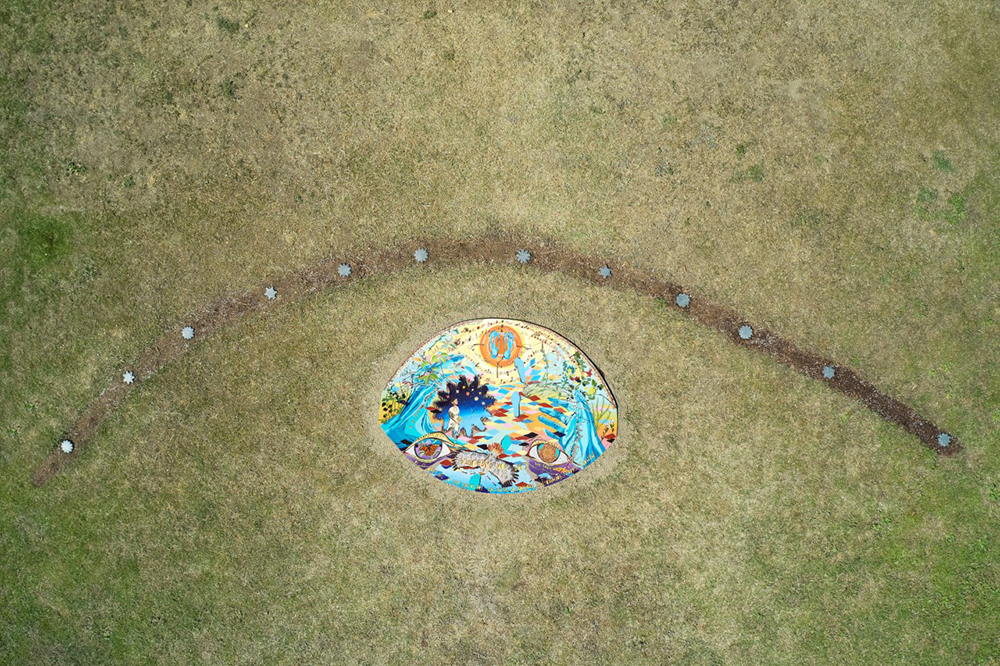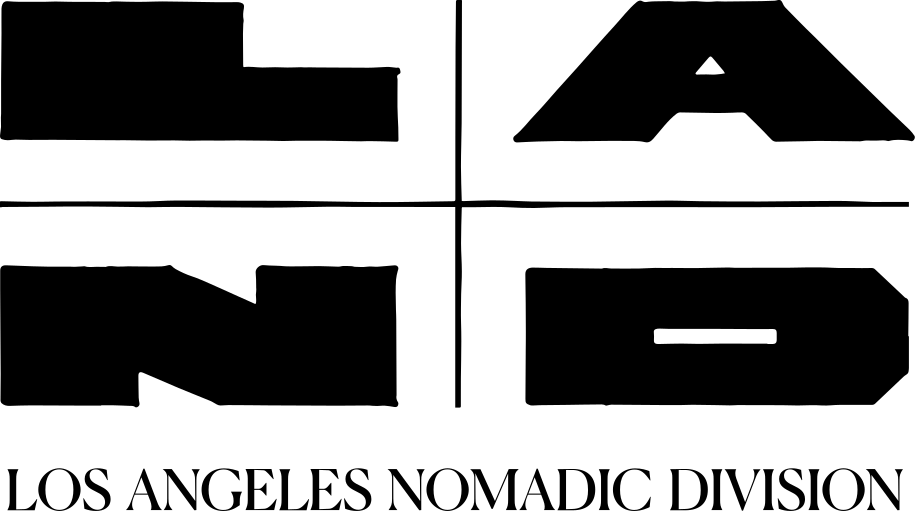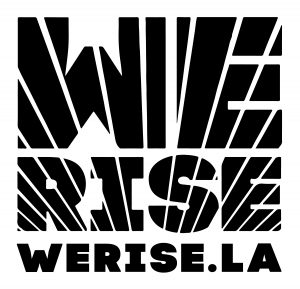
Pakook koy Peshaax (The Sun Enters the Earth and Leaves the Earth)
Los Angeles State Historic Park
1245 N. Spring Street
Los Angeles, CA 90012
May 7 - May 31, 2021
Opening Event: Sundial portraits with Megan Dorame and iris yirei hu
Saturday, May 8
3-5pm PT
The Institute of Contemporary Art Los Angeles (ICA LA) and Los Angeles Nomadic Division (LAND) present a collaboration for WE RISE 2021.
For WE RISE 2021 Julia Bogany (Tongva), poet Megan Dorame (Tongva), and artist iris yirei hu have constructed a human sundial entitled Pakook koy Peshaax (The Sun Enters the Earth and Leaves the Earth) at The Los Angeles State Historic Park. To interact with the sundial, the visitor stands upon a platform, from which their casted shadow tells time. The sundial considers the cycle of life and regeneration by using materials that can rehabilitate the earth. Soil and compost shape the sundial’s arc, onto which each hour is marked by stone replicas of cogstones. Cogstones are discoidal, cog-shaped objects that were carved into different varieties of stone. Because they are believed to have been ceremonial in nature, they are held in sacred regard to the Indigenous people of Southern California. Cogstones have been found throughout the Los Angeles Basin, with their highest concentrations being found along the Santa Ana River and at the Bolsa Chica site in Orange County. The enigmatic stones, which date back to at least 7000 BC, have shaped the Indigenous legacy of Southern California.
In an effort to ground our healing from traumatic and oppressive forces, Tongva elder Julia Bogany often led wellness circles for Indigenous women and youth that began with the question, “Who is the rock beside you?” to call in the relationships that have impacted and supported our lives. Her formative question eventually led the collaborative triad to feature the ancestral cogstones, whose function and meaning continue to be mysterious. In her poem, “Cogstones,” Tongva poet Megan Dorame uses the imagery of these sacred artifacts to question the cultural patrimony of the myriad of looted Tongva tribal objects that are currently displayed in museums. To repatriate these objects to her people, she symbolically throws them into the sky where her ancestors exist as stars. Dorame’s work is rooted in her homeland, the Los Angeles Basin, where she explores the entanglements of settler colonialism and confronts its implications on her community. In her work, she moves between past and present in search of a path towards healing, and ultimately finds her way through the language, images, sounds and songs of her ancestors.
Visitors are invited to stand on a colorful platform that features newly commissioned poetry by Megan Dorame and painted imagery by artist iris yirei hu. The imagery depicts Blue Child, a recurring ancestral figure in hu’s oeuvre, attuning themself to the brilliance of Bogany and Dorame’s Tovaangar while making meaning nearby Dorame words and Bogany’s legacy. In the past, hu and Bogany supported each other in creative and classroom teaching capacities in ways that uplifted Bogany’s advocacy to ensure that the future of her culture, people, and language are bountiful and accessible for generations to come. Together, Bogany, Dorame, and hu present visitors with an offering to connect purposefully to place and affirm our position within the extant systems of the universe. They imagine an alternate possibility for the cogstones’ return by forging a multi-layered path towards healing: To heal the soil is to heal the place we call home, and to heal the place we call home is to heal ourselves.
Pakook koy Peshaax (The Sun Enters the Earth and Leaves the Earth) is presented in loving memory of Julia Bogany, whose legacy lives on in the hearts of the Tongva community and beyond. To learn more about Ms. Bogany, please visit her website at http://www.tobevisible.org.
The project received astronomical consultation from Yuguang Chen, and fabrication assistance from Nicolas Papoin and David L. Bell.
WE RISE encourages wellbeing and healing through art, connection, community engagement and creative expression. Taking place during May: Mental Health Awareness Month, WE RISE 2021 includes Art Rise, a series of 21 art experiences; Community Pop-Ups, hyperlocal activities across Los Angeles County neighborhoods; and a robust Digital Experience, offering original programs that can be enjoyed from anywhere. All installations and activities are meant to be viewed from a distance individually or in small groups, in order to remain COVID-safe while still fostering community connection and collective healing.
An initiative of the Los Angeles County Department of Mental Health, WE RISE is needed now more than ever as the region emerges from the isolation of the global pandemic and continues to grapple with related stressors and racial injustice. This is our opportunity to rise together.
WE RISE events are calls to action, asking you to join a movement to break through barriers and defy old assumptions about mental health and the many related social conditions that compound problems and hurt our communities. WE RISE is the signature experience of the broader WHY WE RISE public education campaign, which is part of a national movement to transform the mental health system and help break through barriers by defying old assumptions about mental health, combatting stigma and recognizing the role that related social conditions play in the wellbeing of individuals and communities. For more information, please visit werise.la
Megan Dorame is a Tongva poet who lives and writes in Santa Ana, California. She holds a BA in anthropology from the University of Oklahoma, and works to reclaim and revitalize the Tongva language. Megan is a 2020 PEN Emerging Voices Fellow and three of her poems have been nominated for the Pushcart Prize. Her work has appeared in Dryland, The Offing, and Best of the Net 2019, among others. Megan compiled and edited the forthcoming book anthology Totoongvetamme Maaynok / Tongva People Create, which brings together art and writing from the Tongva community. She is currently working on her first poetry collection.
Julia Bogany was a teacher, an activist, and an elder of the Tongva tribe dedicated to the teaching, revitalization, and visibility of Tongva language and culture. She worked for over thirty years for the American Indian community and for her tribe. She provided cultural, FASD, ICWA training and workshops in the Los Angeles, San Bernardino, and Riverside areas. She also provided workshops in Sacramento for the California Rural Indian Health Board Woman’s conferences. Ms. Bogany taught Tongva language and cultural classes. She helped to reawaken and revive the Tongva language, as well as assemble a Tongva dictionary.
She was Vice President of the Keepers of Indigenous Ways (KIW), a non-profit group of the Tongva, and President of Residential Motivators, her own non-profit consulting firm. Ms. Bogany served on several committees and organizations: Community Health Worker for Mental Health, California Indian Education Association, Children Court L.A. Round Table for ICWA, and runs co-ed and women’s circles. She was President of Kuruvungna Springs, a Representative for California tribes on Route 66, a member of CNAC (California Native American College board), and Pitzer College Elder-in-Residence at the Claremont Colleges, where she taught native culture and history and women’s issues. In September 2010, she received the Heritage Award from the Aquarium of the Pacific at their sixth annual Native American festival, Moompetam. Ms. Bogany consulted with and trained teachers and school boards on how to revise their curriculum to reflect the correct history of California and California tribes. Her desires were to change the future for her tribe, children, grandchildren, and great grandchildren.
iris yirei hu is an artist from Los Angeles. She uses her hands to weave, tell stories, transform, dye, and compost her lived reality. She sees painting, weaving, natural indigo dyeing, collecting earthly specimens, and working with soil and fibers as ways to redeem the embodied intimacy we once had with the natural world. She often makes colorful, haptic, and large assemblages, in which one may encounter materials, stories, living organisms, and ecologies from Taiwan, California, Southern China, Mexico, and the American Southwest. Her work allows her to form connections with artists, scientists, historians, keepers of traditions, and community stakeholders and organizers, and sees these relationships as futures and friendships.
She has shown her work at the Plug-in ICA (Winnipeg, Manitoba, Canada), Los Angeles Contemporary Exhibitions (LACE), OxyArts at Occidental College, John Michael Kohler Arts Center (Sheboygan, WI), Los Angeles Municipal Art Gallery, Women’s Center for Creative Work, Human Resources, Lenfest Center for the Arts (New York, NY), and Visitor Welcome Center. Public art commissions include mural wraps at California State University Dominguez Hills (2020) and bus and rail posters for LA Metro (2016). She has held residencies at the Women’s Center for Creative Work (2018), Carrizozo AIR (2020), and Los Angeles Cleantech Incubator (2021). She has been supported by the Foundation of Contemporary Art, Rema Hort Mann Foundation Artist Engagement Grant, and is a 2016 Paul & Daisy Soros Fellow. Her work has been reviewed and featured in the LA Times, Artforum, Carla, American Craft Magazine, CNN, Sinovision, KCET, X-TRA Online, and Artillery. She is working on her first book. She earned her BA from UCLA and MFA from Columbia University in the City of New York.
LAND’s 2021 exhibitions are made possible with lead support from the Offield Family Foundation and the Jerry and Terry Kohl Foundation. Additional support is provided by the the Los Angeles County Department of Arts and Culture, the California Community Foundation, the J. Paul Getty Trust Foundation, Fran and Ray Stark Foundation, the Chauncey and Marion D. McCormick Family Foundation, the Poncher Family Foundation, Brenda Potter, and LAND’s Nomadic Council.

